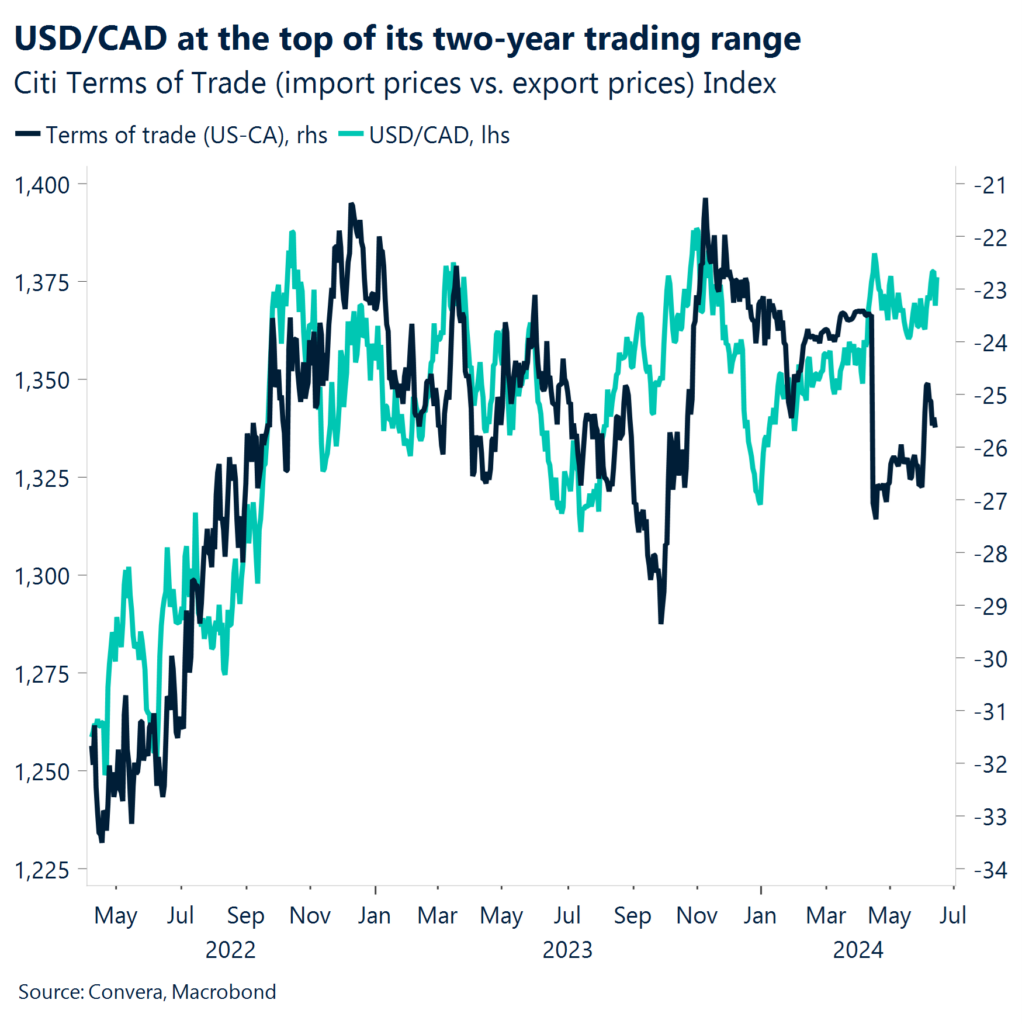Three developments in the form of Emmanuel Macron calling for a snap election, US inflation surprising to the downside and the Fed cutting its rate projection from three to one cuts for 2024 led to some very volatile trading across assets.
US bond yields on the longer end (10, 30-year) recorded their largest weekly drop so far this year on safe-haven flows and a strong disinflationary narrative. US equity markets pushed to new all-time highs while Europe traded lower on risk aversion.
The one-year volatility on EUR/USD surged to the highest level in six weeks as options traders incorporated the French election at the end of the month. The spread between French and German yields widened to a 5-year high.
The US CPI report from Wednesday showed headline inflation stagnating on the month for the first time in almost two years with the annual core measure falling to a three-year low of 3.4%.
European policy makers are cautioning speculators against expecting too many interest rate cuts this year just a week after the central bank eased its monetary policy for the first time in five years.
The safe haven Swiss franc has had another strong week amidst the rising political turbulence across Europe. GBP/EUR rose to the highest level since mid 2022.
Looking ahead, we will focus on the incoming macro data and new developments regarding Chinese fiscal and monetary policy and the French elections.
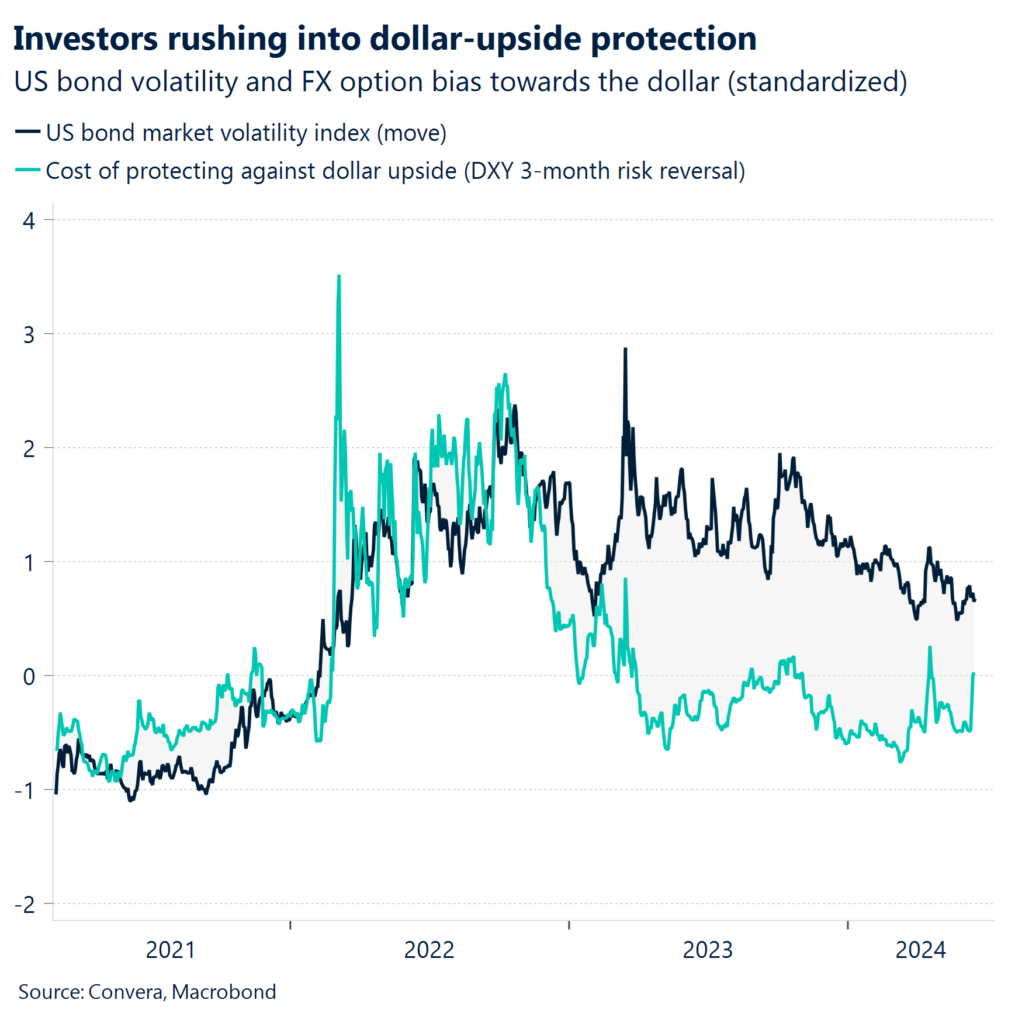
Global Macro
Inflation and French jitters trump the Fed
Fed meeting outdated already? The FOMC now sees core PCE inflation at 2.8% in 2025 (vs. 2.6%) and the unemployment rate at 4.2% (vs. 4.1%). The growth outlook remained the same. Without the context of the CPI report, this rate decision would have been seen as hawkish. However, investors seem to interpret the Fed’s rate projection as already priced in and almost outdated given the inflation print for May. This point is highlighted by markets still expecting the Fed to cut rates in September and December this year.
Macro overshadows the Fed. A strong non-farm payrolls report on Friday and French president Emmanuel Macron announcing a snap election on Monday lead to some volatile trading on FX markets early on this week with the euro suffering the most from a flight to safe-haven currencies. Bond yields across the world jumped due to the US economy seemingly having remained resilient and investors pricing in political risk premia into European sovereigns. This all changed during yesterday’s session when US inflation surprised all expectations to the downside, setting off a capital rotation back into risk assets like the euro, pound, and equities. Not even the hawkish upside revision of the Fed’s inflation and rates projection was enough to make up for the weak CPI report.
Volatility is back, thank politics. The aftershock of President Emmanuel Macron calling for a snap election continues to work its way through markets. FX options are pricing in higher volatility and a stronger bias against the common currency following the surprise result on Sunday. The one-week risk reversal widened by 50 basis points and reached a two-month low, showing a negative option skew against the euro vs. the US dollar. The one-year volatility on EUR/USD surged to the highest level in six weeks as options traders incorporate the French election at the end of the month. However, the fixed income space has been the most sensitive to the recent political developments with the 10-year spread between French and German government bond yields rising to their widest since 2017.
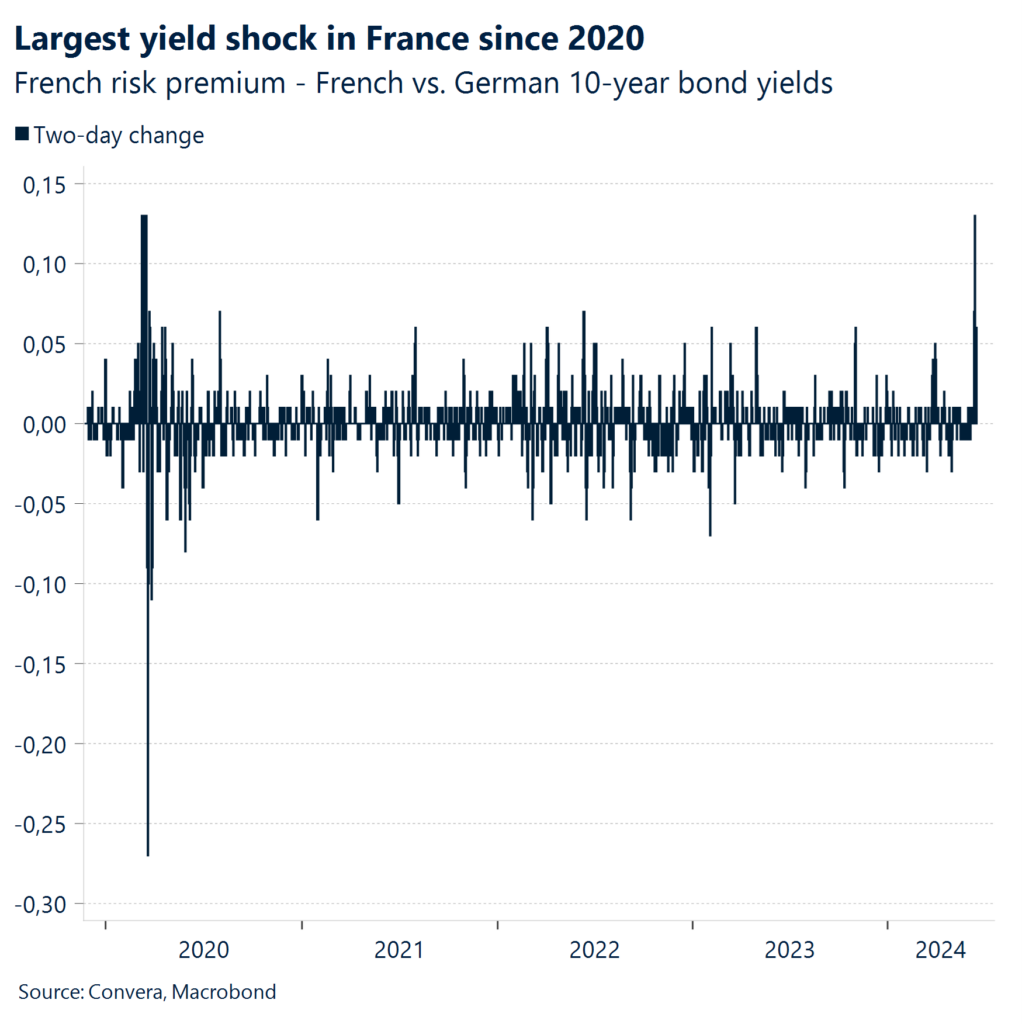
Regional outlook: United States
Disinflation now, reflation later?
US disinflation gains traction. The narrative of the US disinflation continues to gain credibility among market participants as both the consumer and producer price indices for the month of May surprised to the downside this week. US inflation stagnated for the first time in almost two years on a monthly basis, printing a growth rate of 0%. The annual headline number fell from 3.4% to 3.3% in May with core inflation declining to 3.4% and therefore setting a three-year low. The CPI report from Wednesday showed headline inflation stagnating on the month for the first time in almost two years with the annual core measure falling to a three-year low of 3.4%. The PPI report continued the wave of optimism with another negative print, coming in at -0.2% for the month and 2.2% on a year-on-year basis. This could translate to two cuts from the Federal Reserve this year.
Weaker labor market ahead. The labor market is the second piece in the Fed’s monetary policy equation, and it does not help that we have been getting some contradictory data on that front. The stronger-than-expected labor market report last Friday led to a sell-off in bonds and the rise of the US dollar. However, yesterday’s increase in the initial jobless claims by 13 thousand to 242 thousand does suggest some weakness in the labor market. The unemployment rate climbed to 4.0% last month and unemployment benefits are now at the highest since 2023.Fed leaves policy rates unchanged. The CPI report overshadowed the Fed’s rate decision looking purely at the market’s reaction to both events. However, the FOMC meeting was not as lacklustre as economists had expected. The benchmark policy rate remained unchanged at 5.25% but policy makers revised up their rates and inflation projection with the median dot-plot showing just one instead of three cuts for 2024.
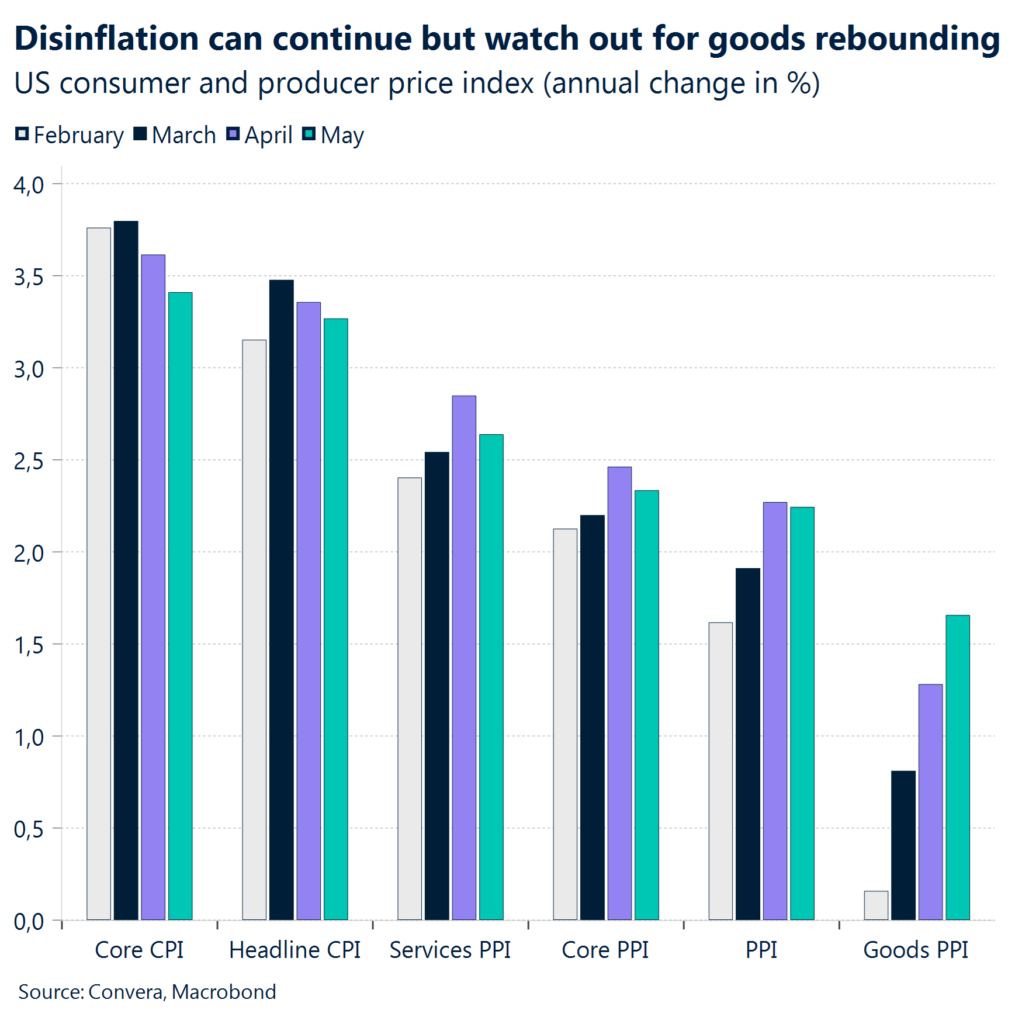
Regional outlook: Eurozone
ECB embraces the hawks just after cutting rates
Slow and painful recovery. The recent flow of leading indicators and survey data suggests that the European economy is out of the woods and the stagnation of 2023. Even the GDP number for Q1 came in better than expected with a growth rate of 0.3%. Nonetheless, we are constantly reminded by the incoming hard data that leaving behind the economic weakness and transitioning into a sustainable growth path remains challenging. The Eurozone industrial sector entered the second quarter of the year on weaker footing with production falling unexpectedly by 0.1%.
Hawkish ECB. On the monetary policy front, European policy makers are cautioning speculators against expecting too many interest rate cuts this year just a week after the central bank eased its monetary policy for the first time in five years. President Christine Lagarde began the week by saying that rates won’t be on a linear declining path. A plethora of her colleagues joined in on the chorus, strengthening the consensus around skipping the July meeting and focusing on a potential rate cut in September. Governing Council members Nagel, Simkus, Rehn and Villeroy sounded surprisingly conform, stating that the ECB (1) must not rush nor dally after decisions to cut, (2) wont pre-commit to any path and (3) can’t declare victory over inflation yet.
Inflation to slow further. All this comes against the backdrop of inflation reaccelerating in May. We do see the potential for inflation to pick up around the end of Q3 in what we describe as a two-step process. However, the first step is a likely continuation of the disinflation process, which could see the headline inflation in the Eurozone and Germany fall below the 2% in the months ahead. It will be interesting to see if the ECB can maintain its hawkishness against such a backdrop as well.
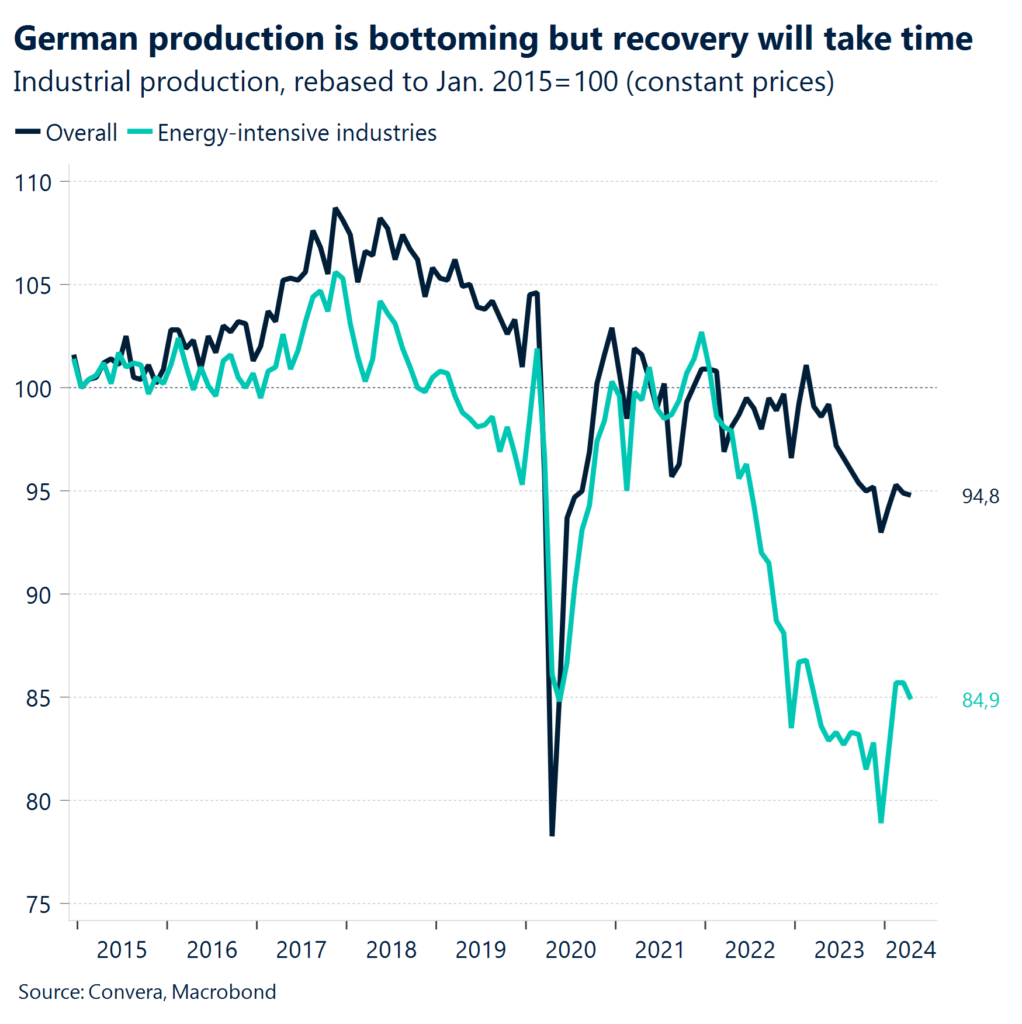
Week ahead
Volatile setup going into the BoE decision and PMI’s
Equities at all-time highs. The disinflation in the United States continued last week and led investors into both equities and bonds. The S&P 500 reached another all-time high while Treasury yields on the long end fell by the most in any week this year. The US dollar did not suffer from this usually fatal capital flow as political tensions in Europe and trade tensions between China and the West came to the forefront this week. Looking ahead, we will continue to focus on the incoming macro data and new developments regarding Chinese fiscal and monetary policy and the French elections.
A big week for UK markets. Markets don’t expect any change in policy from the Bank of England next week, mainly due to the recent string of higher-than-expected inflation and the upcoming election in July. Still, policy makers are likely to take the opportunity to prepare markets for a potential easing at the meeting in August. We will keep an eye out on the number of officials voting for a cut next week and if Governor Bailey continues to push against markets pricing in so little policy easing for this year. We see the meeting and potential downside surprise on UK CPI next week as potentially negative for the pound.
Early data for June and late May. The US retail sales and industrial production data will likely be the macro highlight of the week as investors continue to gauge how the worlds largest economy performed in Q2. Sales surprisingly stagnated last month after a strong finish to Q1. Another data miss would most likely hit the US dollar. From a global perspective, the upcoming purchasing manager indicators will be carefully watched as the first data for the month of June.
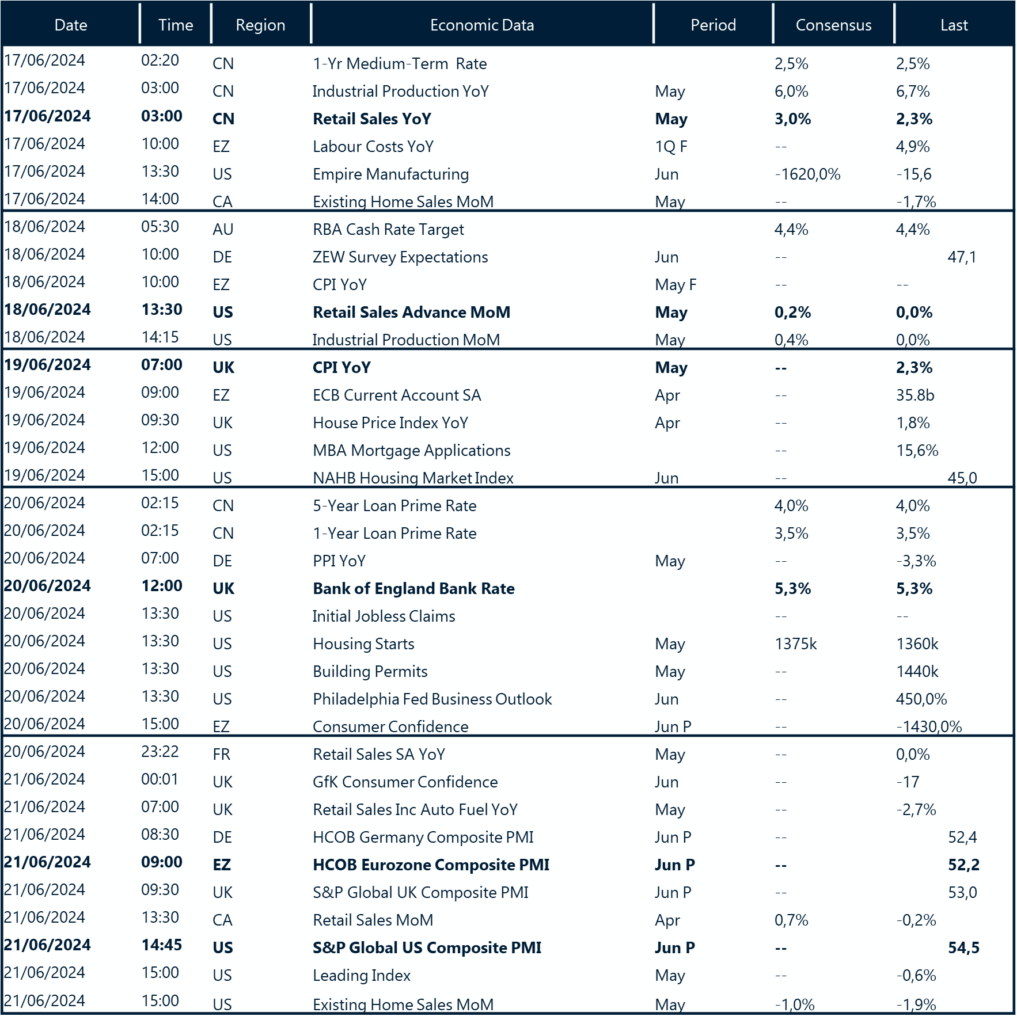
FX Views
US CPI trumps Fed, EU elections
USD CPI drop keeps rate cut hopes alive. The US dollar started the new week near one-month highs after the non-farm employment report beat expectations. The May jobs report came in at 272k new jobs – well above the 180k forecast. Average hourly earnings were also higher than expected. However, the strength reversed after a shock drop in US inflation on Wednesday. Headline CPI was flat in May – versus forecasts for 0.1% – down from 0.3% in April. The annual rate was 3.3%, also below forecasts, and down from 3.4% last month. That said, a more cautious statement from the US Federal Reserve saw the greenback regain some losses. Fed chair Jerome Powell said the central bank will need to remain data dependent. The so-called “dot-point” projections now see only one rate cut in 2024. The USD index remains in a long-term uptrend and supported by the 100- and 200-day moving averages around 104.50. Next week, the focus is on retail sales on Wednesday and PMIs on Friday.
EUR Far-right’s rise drives euro’s fall. The euro was sharply lower as markets reacted to the strong showing of far-right parties in EU parliamentary elections and the snap national election called by French president Emmanuel Macron on Monday. The euro was already on the back foot after the European Central Bank had earlier cut interest rates, dropping their main refinancing rate by 25bps to 4.25%. The EUR/USD weakness – it fell to the lowest level in six weeks – faded after the US’s CPI miss hit the greenback but was short lived due to rising risk premia in Europe. The euro might have some level of support after the ECB raised inflation forecasts for 2025 – from 2.0% to 2.2% – and as a result the central bank is seen as less inclined to cut rates further. The EUR/USD remained on a downward trajectory this week and fell below the important $1.07 level for the first time since May.
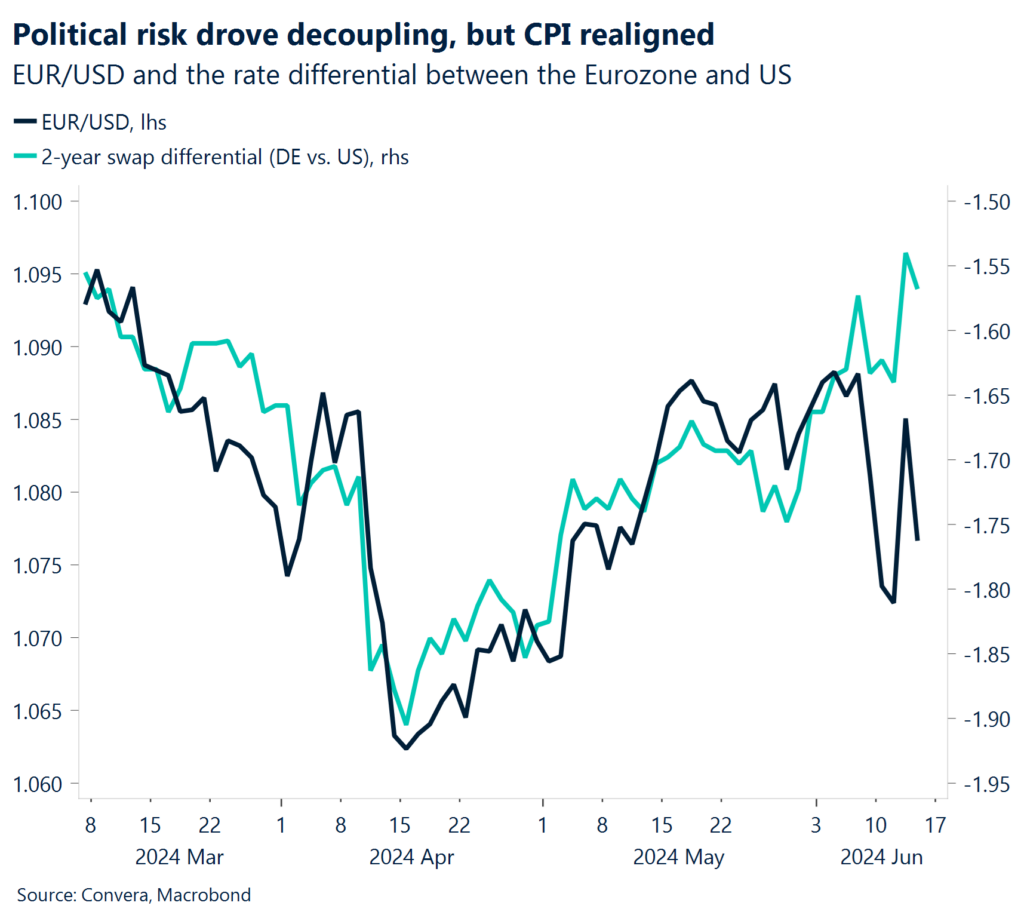
GBP Flirting with multi-month highs.. The British pound rose to a 3-month high against the US dollar following the softer US CPI print and is flirting with its 200-week moving average. Back in March, GBP/USD reversed course from this strong resistance level and fell over 4% in six weeks. But Fed rate cut bets were being dialled back at that point. Now they are being dialled up. Against the euro, sterling hit its highest level since August 2022 amidst the political risk emanating from France. Over the past eight years, since the EU referendum in 2016, GBP/EUR has traded above €1.18 for only 8% of the time. Whilst external factors have been more influential in moving GBP than domestic data and UK election developments, we think markets are underpricing the chance of a BoE rate cut this summer. The pound may lose some of its recent momentum if UK services inflation comes in cooler than expected next Wednesday, as it would raise the probability of a BoE cut in August and bring rates differentials back to the fore, especially when it comes to GBP/EUR.
CHF Clawing back YTD losses. The safe haven Swiss franc has had another strong week amidst the rising political turbulence across Europe, which sparked a risk off environment. The franc was down, on average, 5% against its global peers year-to-date in late May, but has clawed that back to just 2.5%. The franc has gained around 3% against both the US dollar and euro over the past three weeks following what was its worst start to a year on record versus the latter. As well as safe haven flows of late, CHF has been supported by recent data showing Swiss inflation held at its fastest pace this year, eroding the case for a Swiss National Bank interest-rate cut when officials meet this coming Thursday. This comes at a time when speculative traders grew their net short Swiss franc position in the latest week to the largest in almost six years.

CNY China inflation steadies, producer prices see narrower decline. China’s consumer price inflation stabilized at 0.3% year-on-year in May, slightly missing forecasts but maintaining a positive trajectory for the fourth consecutive month. While food prices continued to decline, the core inflation measure ticked up, suggesting underlying price pressures. Notably, the stability in headline inflation may partially stem from administrative actions rather than robust domestic demand. On the producer side, the decline in prices narrowed significantly, marking the slowest pace of deceleration in over a year, buoyed by higher commodity prices and a favorable base effect. As traders dissect these economic indicators, they should monitor key domestic data releases, such as fixed asset investment, industrial production, and unemployment rates.
JPY Japan’s producer prices surprise on the upside. Japan’s producer price index (PPI) for May exceeded expectations, rising 2.4% year-on-year and 0.7% month-on-month, marking the largest increase in 18 months. While export prices across various categories moderated on a monthly basis, import prices saw notable increases, driven by sectors such as metals, textiles, wood, and oil and gas. The stronger PPI and import prices can be partially attributed to the weaker yen. However, addressing this through interest rate hikes could potentially dampen domestic demand, highlighting the policy dilemma facing the Bank of Japan. The USD/JPY currency pair trades within a tightening range above key technical levels, with next crucial resistance at 159.76-160.45. Chart shows Yen appears to be undervalued in the short term given the FX pair should correlate with the rate differentials. Traders should monitor upcoming domestic data releases, including exports, trade balance, and national core inflation figures.

CAD More divergence to come? The Canadian dollar remains in a broadly weakening phase after the Bank of Canada cut rates by 25bps to 4.75% on 5 June. USD/CAD pushed higher to reach two-month highs although the market did reverse from those highs after the US’s weaker inflation reading on Wednesday. That said, key long-term momentum indicators like the 100- and 200-day moving averages continue to signal the upward bias in the USD/CAD. BoC governor Tiff Macklem most recently said there is room for further divergence between the Fed and BoC in a move that could pressure the CAD further lower. Key resistance is seen at 1.3800 and 1.3850. USD buyers will be looking for a pullback to support just above 1.3600. Monday’s housing starts is the only notable release.
AUD Aussie business sentiment sours as cost pressures intensify. The Australian business landscape experienced a shift, with confidence levels taking a dip into negative territory according to the National Australia Bank’s latest figures. While business conditions remained above average, growth in sales and profits slowed, painting a concerning outlook. Interestingly, cost pressures showed signs of re-acceleration across retail prices, labor costs, and purchasing costs. This mix of factors presents a complex scenario for the Reserve Bank of Australia as it navigates policy decisions. With the tailwind from commodity trends waning, the Australian dollar struggles to maintain its upward momentum, trading precariously above a key technical breakout level against the US dollar at 0.6584-0.6629 moving averages. Traders should keep a watchful eye on upcoming RBA rate decisions.
